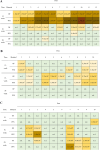Field study on the suitability of oral fluid samples for monitoring of Lawsonia intracellularis and Brachyspira hyodysenteriae by multiplex qPCR under field conditions
- PMID: 39773664
- PMCID: PMC11706030
- DOI: 10.1186/s40813-024-00415-4
Field study on the suitability of oral fluid samples for monitoring of Lawsonia intracellularis and Brachyspira hyodysenteriae by multiplex qPCR under field conditions
Abstract
Background: Monitoring or surveillance of infectious diseases is crucial in terms of herd health management of livestock. Investigations of oral fluids have become an animal friendly routine strategy to monitor respiratory pathogens in pigs. Less is known about the suitability of oral fluids for the detection of enteric pathogens in swine. In the present study we evaluated the use of oral fluids to monitor B. hyodysenteriae and L. intracellularis compared to pooled fecal samples by multiplex qPCR in a pen-wise follow-up of fattening pigs. Therefore, we collected oral fluids at an age of 12, 16 and 20 weeks of life and compared them to pooled fecal samples collected from the same pens on two fattening farms.
Results: Cohen´s Kappa analysis revealed a substantial agreement between oral fluids and pooled fecal samples on pen level (Cohen´s Kappa: 0.745; p < 0.001). DNA-loads of L. intracellularis were tendentially higher (p = 0.053) in pooled fecal samples than in the corresponding OFs.
Conclusions: The present study shows that oral fluids are an appropriate tool to monitor B. hyodysenteriae and L. intracellularis on conventional fattening farms under field conditions. However, multiple pen testing should be conducted to increase the diagnostic performance and sensitivity.
Keywords: Enteric diseases; Fattening; Livestock; Screening; Swine.
© 2025. The Author(s).
Conflict of interest statement
Declarations. Ethics approval and consent to participate: Ethical approval was waived as oral fluid sampling is not rated as animal testing by the appropriate authority (Az. 2532.Vet_03-18–43). Consent for publication: Written informed consent was obtained from the owners of the animals. Competing interests: The authors declare no conflicts of interest.
Figures



Similar articles
-
Prevalence of Lawsonia intracellularis, Brachyspira hyodysenteriae and Salmonella in swine herds.J Vet Sci. 2005 Dec;6(4):289-93. J Vet Sci. 2005. PMID: 16293991
-
Analysis of bacterial load and prevalence of mixed infections with Lawsonia intracellularis, Brachyspira hyodysenteriae and/or Brachyspira pilosicoli in German pigs with diarrhoea.Berl Munch Tierarztl Wochenschr. 2011 May-Jun;124(5-6):236-41. Berl Munch Tierarztl Wochenschr. 2011. PMID: 22059295
-
Prevalence and risk factors of Brachyspira spp. in pig herds with a history of diarrhoea in six European countries.Prev Vet Med. 2023 Apr;213:105862. doi: 10.1016/j.prevetmed.2023.105862. Epub 2023 Feb 2. Prev Vet Med. 2023. PMID: 36774781
-
[Distribution of Brachyspira hyodysenteriae and Lawsonia intracellularis in healthy and diarrhoeic pigs].Berl Munch Tierarztl Wochenschr. 2004 Nov-Dec;117(11-12):493-8. Berl Munch Tierarztl Wochenschr. 2004. PMID: 15584431 German.
-
Review of methods for the detection of Lawsonia intracellularis infection in pigs.J Vet Diagn Invest. 2021 Jul;33(4):621-631. doi: 10.1177/10406387211003551. Epub 2021 Mar 19. J Vet Diagn Invest. 2021. PMID: 33739176 Free PMC article. Review.
References
-
- Kittawornrat A, Zimmerman JJ. Toward a better understanding of pig behavior and pig welfare. Anim Health Res Rev. 2011;12(1):25–32. - PubMed
-
- Kittawornrat A, Panyasing Y, Goodell C, Wang C, Gauger P, Harmon K, et al. Porcine reproductive and respiratory syndrome virus (PRRSV) surveillance using pre-weaning oral fluid samples detects circulation of wild-type PRRSV. Vet Microbiol. 2014;168(2–4):331–9. - PubMed
-
- Biernacka K, Karbowiak P, Wrobel P, Chareza T, Czopowicz M, Balka G, et al. Detection of porcine reproductive and respiratory syndrome virus (PRRSV) and influenza A virus (IAV) in oral fluid of pigs. Res Vet Sci. 2016;109:74–80. - PubMed
LinkOut - more resources
Full Text Sources

